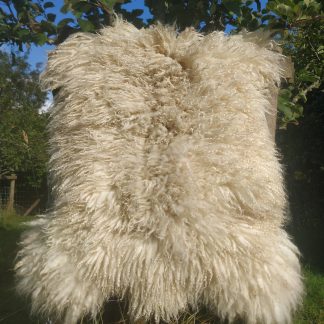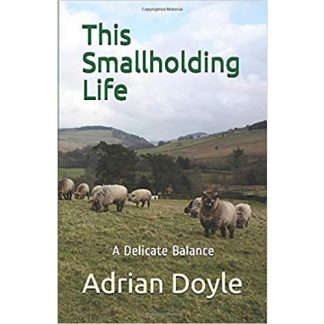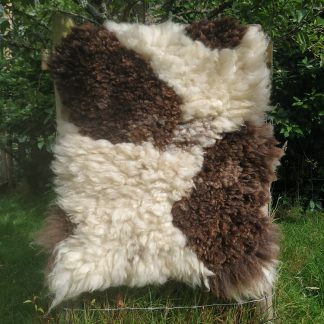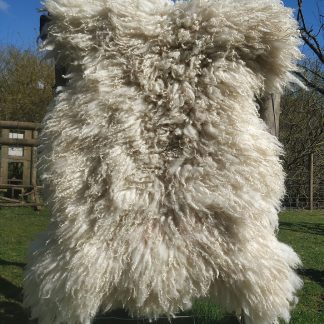
Last year we came to the realisation that our hens had gone a little too feral for our liking. This might not seem to be a problem on the surface of it, indeed if asked, the hens would probably say they had a lovely time with their wild camping expeditions and minimal interference from two legged creatures in wellies.

However, as smallholders we like to think our animals go some way towards paying for their keep. After all, the reason we have hens is so we can have eggs. Last summer though, it had got to the point where we had virtually no eggs whatsoever and were starting to question why we were spending a fortune on layers pellets and corn for a bunch of hens living out wild.
In the autumn we accidentally solved the egg mystery, we found a huge clutch nestled in a clump of sedge grass while moving the hen coops. Sadly we had to throw them out as they’d been there for months. The hens were not only sleeping wild in bushes, they were laying their eggs wild too and they’re very good at keeping the location of their nests secret. We never would have found those eggs if it hadn’t been for moving the coops.
This year, happily we have eggs again. The hens have reacquainted themselves with their coops and are laying for all they are worth, hoorah!
Nevertheless our feathered friends are still on the nervous side and prefer to keep us at arms length. The “bibbles” (last year’s chicks) are fast learning from the older hens to keep us at a distance and they certainly don’t appreciate being picked up as we discovered recently when we had to give the chicks’ bottoms a wash.
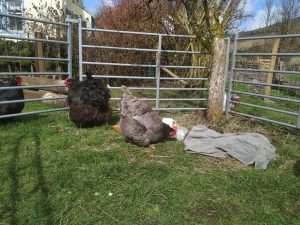
Orpingtons are rather prone to “dangle berries”, (dags). Their long, glamourous bottom feathers can easily get messy, and dirty bottoms isn’t a good situation. Unfortunately hens cannot reach round to preen their bottom feathers so unless we help them out, those dangle berries would get bigger and bigger and cause the hen a lot of distress, not to mention putting her at risk from fly strike.
So with frequent bottom patrols on the cards for the Orpingtons, this year we decided to schedule in daily cuddle training so that eventually we’d be able to pick up a hen without any drama. We have kind of managed this already with Cherokee the cockerel. He has foot problems and the frequent work we do on him means he doesn’t fly into a blind panic when we give him his pedicures.
From a broader perspective, we’ve always maintained that to get the most out of livestock and build a good relationship, the best thing is to spend quality time with your animals on a daily basis. There are no shortcuts because it takes time and consistency to build up trust. But once you’ve got to the point where your animals allow you into their space, it’s really special. It also makes life a lot easier if you have to help them out of pickles (frequently in the case of sheep), or give them medication, usually this is an injection. It can be quite distressing for example if your sheep tenses up whilst giving it a jag. Their energy feeds off our energy and creates a negative feedback loop. Coming into the pen for any sort of treatment, let alone an injection becomes a negative experience. Far better to help out an animal who’s already used to our presence and relaxed in our company. It makes handling livestock a million times better for everyone involved.

So we have made space in our day to cuddle-train the hens. The plan is to have a cup of tea with our feathered friends at 11am daily and allow their natural curiosity to overcome their shyness. Hens are very inquisitive, and they’re also experts at sniffing out snacks. We make sure we bring them raisins and other little treats and sprinkle these around whilst enjoying our cuppas. We’ve hurdled off an area where we can sit with them and have even ordered a picnic bench to make the cuddle corner extra comfy. The hurdles will make things easier when we start picking them up.
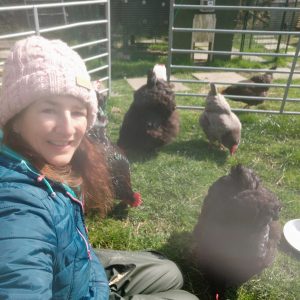
We’ve thought carefully about our strategy and decided to start off working on one hen, the more confident of the Orpingtons, Becky McPecky. She’s a natural born leader and one day she’ll probably rule the roost when our current lady boss Clippy decides to retire. Working with a naturally confident hen will bring the others in, they’ll watch and learn (well that’s the idea anyway).
So far the cuddle training has gone well and I’ve written up a little diary of the milestones so far:
7th April: Started training. Brought out a tray out with a cup of tea and toast for me and treats for the girls (and Cherokee). Most of the hens came into the pen and hoovered up the treats around my feet. Some of the shy girls stayed on the outside but seemed more curious than nervous. Threw some treats to the shy girls to build their confidence.
15th April: Picked up Becky McPecky. She was a bit non-plussed but I rewarded her with a raisin. Kept my hand on her back to prevent her from flapping and let her know not to worry. (A hand on the back done the right way helps to calm a flappy hen).
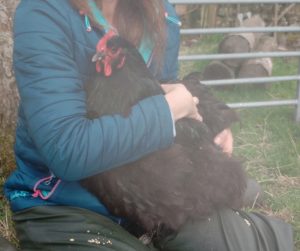
19th April: Picked up Becky McPecky again, this time I could take my hand off her back and she stayed on my lap. Rewarded her with 3 raisins and some corn. Let her hop off in her own time.
23rd April: Thought I had picked up Becky McPecky but realised it was Babs Bikini Bottom. Realised this when said hen was more flappy than usual. On putting her down I noticed her neatly trimmed bottom feathers. (I have started trimming the Orpington’s bottom feathers and have so far got round to doing two; Babs and Belinda). On a side note, since my blog story about washing hens’ bottoms, I’ve read that it’s fine to trim the bottom feathers rather than wash them and this is actually advisable because once trimmed, the feathers will stay short all through the summer).
So far all’s going well and I’ll continue to record my progress. By the end of the summer I hope all our hens will be happy to be picked up and cuddled. I hope to find their individual tickle spots and learn more about their unique personalities and characters.



